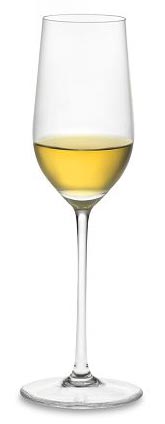
This article appearded in the February/March 2007 edition of Connections Magazine (Ireland)
There can't be a more misunderstood type of wine than Sherry.
People tend to lump all of its different styles into one group, usually associating the whole lot with Harvey's Bristol Cream, a sweet brown stodgy drink that was (and still is in some locales) the elixir of little old ladies; the least common denominator of Sherry. The Sherry industry would like to replace this stereotype with a more urbane, cool, and sexy image but their efforts always seem to fall short. Or a least miss the point. Why try to sell gloss when the real story is more than compelling? Sherries are simply some of the world's great wines but more importantly can be incredibly delicious and extremely food-friendly.
Perhaps the most misunderstood style of sherry is Fino, best known as the ubiquitous Tio Pepe. Somehow a green bottle of Tio Pepe manages to find its way into every bar and airport lounge in the world. Sadly, they're usually treated like just another bottle of liquor, opened and warm. Since Finos are made to be served fresh and cool just like any other fine white wine, this is the equivalent of keeping an open bottle of Chardonnay in your liquor cabinet. I would imagine that the few orders for warm old glasses of Tio Pepe literally sours Sherry's reputation worldwide.
The confusion may also be due to the fact that Finos were not a large part of the original great sherry trade between Jerez and England that began in the 14th century and peaked in the late 19th century. Since they were made to be consumed fresh, they weren't ideal for shipping like the oxidized styles such as Amontillados and Olorosos. Besides, the British traditionally preferred sweet wines like Harvey's Bristol Cream which was another reason not to ship them abroad. By the time Finos were widely available in the 20th Century, they seem to have been considered and served just like the other styles. Bottles of Tio Pepe in the UK still say to consume the bottle within a month of opening, a practise that anyone from Jerez would consider a travesty, where a bottle of Fino is consumed a few hours after opening.
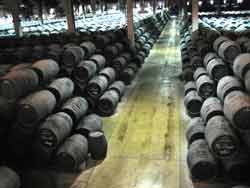
A great deal of care and time is taken in making Fino, a process sometimes compared with the labor-intensive production of Champagne. First, a dry white wine is made from Palomino grapes. The wine is then fortified to between 15% and 15.5% alcohol and put in casks 4/5 full where a layer of oxygen-inhibiting yeast called flor forms on top of the wine. Just as yeast is responsible for a good deal of the character and flavour of Champagne, the flor imparts much of the distinctive flavour in a Fino sherry, with both wines more a product of their process than the vineyard. This doesn't mean that the grapes don't matter, however, as the best grapes are selected to make the best Champagnes and finest Finos.
Finos are also similar to Non-Vintage (NV) Champagne in that they're both blended from several vintages and aged. While NV Champagne must age a minumum of 15 months, Finos stay in their special blending soleras (stacks of 3 to 4 casks) at least 3 years and often 5 or more. Amazingly, this remarkable amount of extra care and costly maturation doesn't translate into higher prices. A bottle of the world's best selling Fino, Tio Pepe will set you back about 10 euros while the world's best selling Champagne – NV Moet & Chandon Brut – goes for around €35.
Manzanilla is a distinctive type of sherry made in the same way as Fino but with one major difference. Manzanillas are produced only in the seaside town of Sanlúcar de Barrameda and because of its cooler climate, the flor layer grows much thicker and doesn't burn off in the heat of summer as it does for the Finos aging in Jerez. The additional flor gives a more sauvory, slightly bitter tang to the wines.

Fino means fine in Spanish and accordingly the greatest expression of a Fino (or Manzanilla) sherry is very delicate, light and elegant. Aromas of almonds are a classic characteristic. They should also be deliciously refreshing, clean and dry, with just the right balance of acidity, extract and alcohol so that none of these elements are overt on the palate. Cellarmasters grade the wine during production so that the coarser wines go into less expensive bottlings while the most elegant ones are reserved for the finest wines. The intention here is in stark contrast to winemaking in much of the world, where the goal is more intense flavors and more opulent wines as opposed to subtlety and finesse.
It's funny to think how Finos and Manzanillas were once considered very alcoholic wines at 15.5% vol. Recently almost all sherry producers have reduced their fortification levels so that Finos and Manzanillas are now just 15.0% alcohol, which seems almost modest compared to some big bold Californian and Australian wines that routinely top 16% without fortification. Sherry may be the only region in the world where the wines are actually going down in alcohol!
Manzanillas and Finos are both great with food and especially tapas, the small plates or snacks served throughout Spain but originated in Andalusia. Acording to legend, tapas was invented when King Alfonso XII, who reigned from 1875 to 1885, ordered a glass of sherry in Cádiz, a seaside city just south of Jerez. To protect the sherry from sand and wind, a piece of cured ham was placed on top of the glass. After drinking the wine and eating the ham, the King ordered another sherry with the same tapa, which means cover in Spanish. And besides Serrano Ham, which is perhaps one of the world's greatest edibles, they go exceptionally well with such tapas as green (Manzanilla) olives, chorizo sausage and Manchego cheese.
Finos and Manzanillas also make excellent aperitifs and should be served very cold, at between 7º and 9º C, which is easy to do since that's refrigerator temperature. The ideal glass is a traditional catavino or copita which is a very small narrow wine glass. ISO tasting glasses are equally good but if you don't have either, champagne flutes or small tulip-shaped white wine glasses will work in a pinch.
Of course the best and most civilized way to experience Fino sherry in its full glory is to visit Jerez. Many Sherry Bodegas welcome visitors in this charming old city and nothing beats a well-chilled copita with a few tapas in one of the local bars or cafes. Jerez is also home to the Flamenco and the world famous Spanish Riding School. See www.turismojerez.com for more information. And when in Jerez, you may want to heed the local advice mentioned in Julian Jeff's classic book, Sherry: always have a mid-morning copita of Oloroso to prepare for the Finos of lunch. Very civilized indeed.
FIVE FABULOSO FINOS: 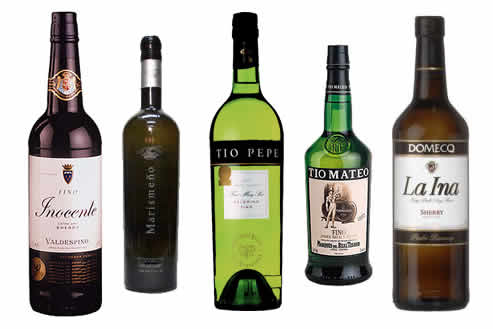
Fino La Ina, Pedro Domecq Domecq, who also make Harvey's Bristol Cream, is one of the largest sherry producers and their Fino La Ina is a good intoduction to Fino, with ripe apple flavours and overtones of oak and vanilla. Very Good.
Domecq, who also make Harvey's Bristol Cream, is one of the largest sherry producers and their Fino La Ina is a good intoduction to Fino, with ripe apple flavours and overtones of oak and vanilla. Very Good.
Inocente Fino, Valdespino Valdespino is the oldest Sherry Bodega, dating back to 1430. Their famous Macharnudo Estate provides the Palomino grapes for Inocente, making it the only single vineyard Fino. This wine was the best of the tasting, very clean and elegant with classic notes of almonds and green olives and a very long intense finish. Outstanding.
Valdespino is the oldest Sherry Bodega, dating back to 1430. Their famous Macharnudo Estate provides the Palomino grapes for Inocente, making it the only single vineyard Fino. This wine was the best of the tasting, very clean and elegant with classic notes of almonds and green olives and a very long intense finish. Outstanding.
Tio Mateo, Marqués del Real Tesoro Grupo Estevez now owns both Valdespino and Marques del Real Tesoro and they share a huge modern facility on the West side of Jerez. Unfortunately, they don't share quality as the Tio Mateo was very poor given the high standard of this tasting. It tastes dilute and alcholic. Poor. OK, let's make that Four Fabuloso Finos!
Grupo Estevez now owns both Valdespino and Marques del Real Tesoro and they share a huge modern facility on the West side of Jerez. Unfortunately, they don't share quality as the Tio Mateo was very poor given the high standard of this tasting. It tastes dilute and alcholic. Poor. OK, let's make that Four Fabuloso Finos!
Tio Pepe, Gonzalez Byass It's easy to see why the ubiquitous green bottle of Tio Pepe is the ambassador for Fino Sherry worldwide. It has a classic and pronounced flavor that is perhaps a bit creamier and solvent-like than most. Excellent.
It's easy to see why the ubiquitous green bottle of Tio Pepe is the ambassador for Fino Sherry worldwide. It has a classic and pronounced flavor that is perhaps a bit creamier and solvent-like than most. Excellent.
Marsimeño Fino, Sánchez Romate Romante is a locally owned Bodega that's currently increasing its global distribution. The Marsimeño is almost golden and richly textured, with pronounced vanilla and a bit fruitier than the others; a new-wave International style Fino. Very Good to Excellent
Romante is a locally owned Bodega that's currently increasing its global distribution. The Marsimeño is almost golden and richly textured, with pronounced vanilla and a bit fruitier than the others; a new-wave International style Fino. Very Good to Excellent
SIX MAGNIFICOS MANZANILLAS: 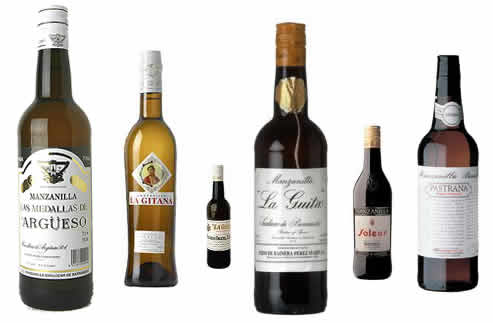
La Gitana, Hidalgo La Gitana, or “the gypsy” is the best selling Manzanilla in the world. It's hard not to like, with a classic savoury salty tang and a delicate licorice and almond aroma. Excellent.
La Gitana, or “the gypsy” is the best selling Manzanilla in the world. It's hard not to like, with a classic savoury salty tang and a delicate licorice and almond aroma. Excellent.
La Guita, Hijos de Rainera Perez Marin The founder of this bodega was known for asking customers “do you have guita?” which is an old Spanish slang word for money. The term also means string, and it sort of stuck just like the piece of string that's attached to every bottle of this unique wine. It has a touch of sweetness with fruity, nutty almost candy like aromas. It's definitely not a typical Manzanilla but easy to see why it's very popular locally. Very Good.
The founder of this bodega was known for asking customers “do you have guita?” which is an old Spanish slang word for money. The term also means string, and it sort of stuck just like the piece of string that's attached to every bottle of this unique wine. It has a touch of sweetness with fruity, nutty almost candy like aromas. It's definitely not a typical Manzanilla but easy to see why it's very popular locally. Very Good.
La Goya, Delgado Zuleta Delagado Zuleta is a large old family-run Bodega in Sanlúcar de Barrameda. Aged 6 to 8 years, it's deeper in colour than your average pale straw Manzanilla, this is perhaps the richest wine of the tasting. Very savoury and buttery with a hint of tomato on the nose. Very Good.
Delagado Zuleta is a large old family-run Bodega in Sanlúcar de Barrameda. Aged 6 to 8 years, it's deeper in colour than your average pale straw Manzanilla, this is perhaps the richest wine of the tasting. Very savoury and buttery with a hint of tomato on the nose. Very Good.
Las Medallas de Argüeso Manzanilla Argüeso also makes the San León Manzanilla that received several awards in London this past year. Las Medallas receives less aging than San León at 5 years as opposed to 8 to 10 years, giving it more freshness than richness. It has a classic nose with some ripe apple and a faint whiff of linseed oil. Very Good.
Argüeso also makes the San León Manzanilla that received several awards in London this past year. Las Medallas receives less aging than San León at 5 years as opposed to 8 to 10 years, giving it more freshness than richness. It has a classic nose with some ripe apple and a faint whiff of linseed oil. Very Good.
Solear, Barbadillo Barbadillo's giant bodega is one of the first things you see when driving into Sanlúcar. Their Solear is a big selling and typically good Manzanilla with hints of almond, olive and paraffin. They also make Castillo de San Diego, a dry light unfortified wine made from 100% Palomino grapes which is a great way to try what Sherry tastes like before fortification and aging. Very Good
Barbadillo's giant bodega is one of the first things you see when driving into Sanlúcar. Their Solear is a big selling and typically good Manzanilla with hints of almond, olive and paraffin. They also make Castillo de San Diego, a dry light unfortified wine made from 100% Palomino grapes which is a great way to try what Sherry tastes like before fortification and aging. Very Good
Pastrana Pasada Manzanilla, Hidalgo Just as Innocente is the only single vineyard Fino, this wine is the only single vineyard Manzanilla, with all of its grapes harvested from Hidalgo's Pastrana vineyard. Since it's a Pasada Manzanilla, it has just started to oxidize and is medium gold in colour with a very classic and refined nose of almond and honeysuckle. Rich yet delicate and very long on the finish, this wine is obviously an aristocrat. A very special wine. Outstanding.
Just as Innocente is the only single vineyard Fino, this wine is the only single vineyard Manzanilla, with all of its grapes harvested from Hidalgo's Pastrana vineyard. Since it's a Pasada Manzanilla, it has just started to oxidize and is medium gold in colour with a very classic and refined nose of almond and honeysuckle. Rich yet delicate and very long on the finish, this wine is obviously an aristocrat. A very special wine. Outstanding.
TYPES OF SHERRY:
Fino A pale straw-coloured wine with a sharp, delicate bouquet suggestive of almonds. It's light and dry on the palate. The wine is fortified to 15% alcohol and aged under a veil of yeasts called “flor” to prevent oxidation. This aging process is sometimes referred to as “biological” in contrast to the “oxidative” aging that other non-flor wines undertake.
Manzanilla A wine made in the same way as Fino, but only in Sanlúcar de Barrameda. In this seaside village, the flor grows more robustly and doesn't die down in the heat of the summer as in Jerez. This special biological aging imparts a distinctive character to the wines.
Manzanilla Pasada A Manzanilla that has aged 5-10 years and has just started to oxide, on it's way to becoming an Amontillado. It is more golden in colour and richer on the palate that a regular Manzanilla.
Amontillado A Fino or Manzanilla that has aged 8 years or more and has become oxidized and nutty in flavour. It's often considered the most representative style of sherry since it shares both biological and oxidative qualities. Made fully dry but often sweetened for export. Between 16º and 22º alcohol.
Oloroso The term means odorous in Spanish and this style does have the strongest and most pronounced bouquet suggestive of walnuts. A fully oxidative style of sherry that has aged without flor, it becomes progressively richer and complex with age. Between 17º and 22º alcohol.
Palo Cortado A rarity in that only 1 in 1,000 butts of sherry becomes a Palo Cortado. Its character is a hybrid with a nose of Amontillado but like an Oloroso on the palate. A true sherry connoisseur's delight. Between 17º and 22º alcohol.
PX PX is an abbreviation for Pedro Ximenez, the grape this wine is made from. The grapes are dried like raisins before fermentation and the resulting wine is very sweet and raisin flavoured. Although its normally used as a sweetening agent, on its own it's one of the world's sweetest and richest wines.
Pale Cream Sherry A sweetened Fino. Croft's is a best selling brand.
Cream Sherry An Oloroso sweetened with PX. Harvey's Bristol Cream is a top seller.
Moscatel Made from raisined grapes in the same way that PX is except from Moscatel grapes.

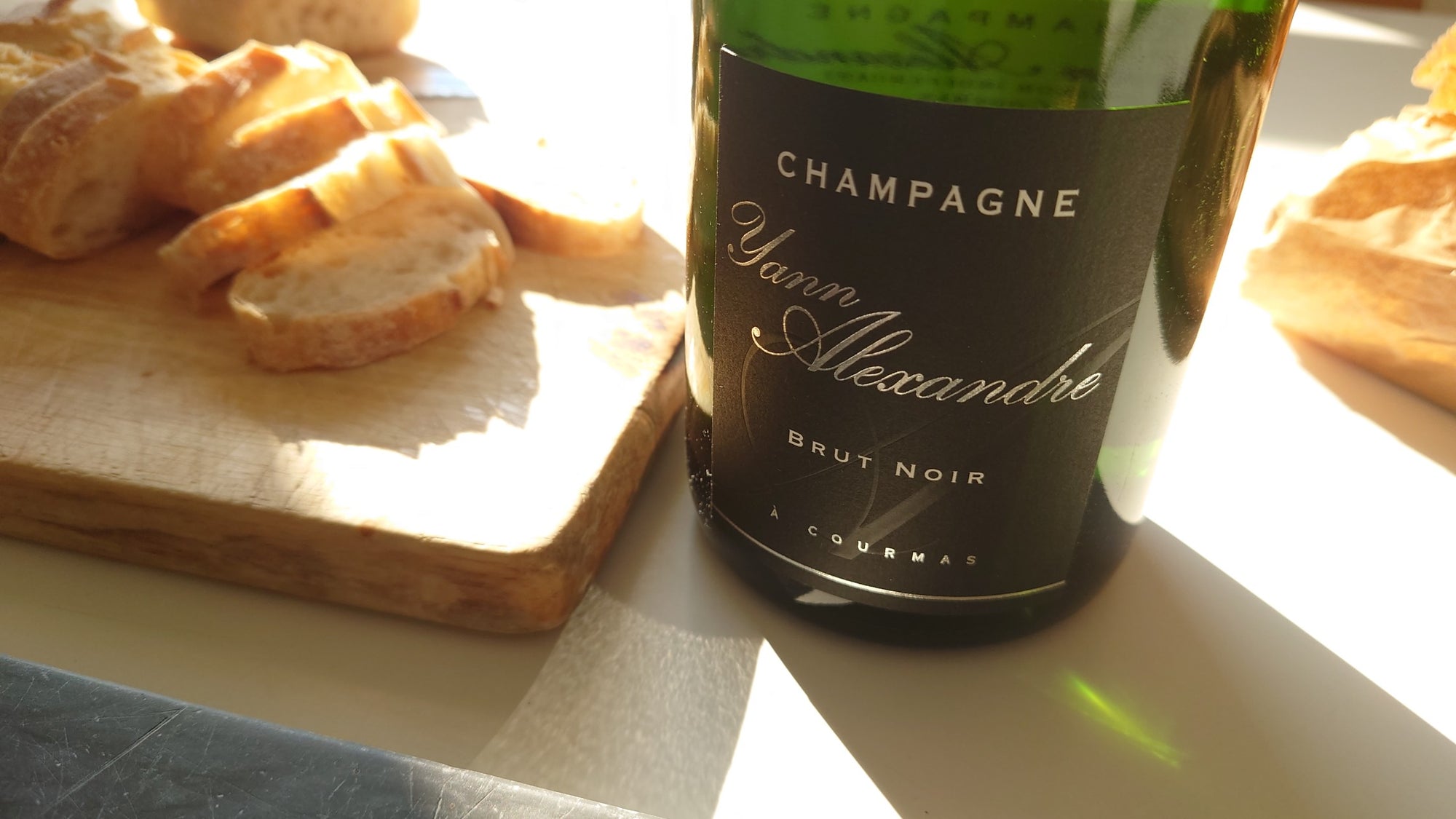
Comments
I lived in El Puerto de Santa Maria for 25 years, was accepted as a local even though the real locals never called me by name, I was always, El Americano.
The Osborne, Domecq, Hidalgo and Orleans-Borbon families were the folks I hung out with, my two closest friends are named Hidalgo and Orleans-Borbon. Rafael Osborne has owed me $50 since the late 90s for a sail I picked up for him in Gibraltar. I’m sure I have recovered that 100 times over in Fino y Jamon.
Back to the Sherry, it is the nectar of the gods. My favorite was made by the Terry family, they lost the formula back in the last century.
The best place to enjoy a Sherry is with friends. The Real Club Nautico and Bar Jamon in El Puerto, on the Riverfront in Sanlucar at Sunset or the Plaza Mejor in Jerez are all great places to enjoy friends and wine.
But best for me was the Feria season. I never met a stranger at any Feria from Sevilla to Cadiz. 100’s of thousands of people I had never met before but no strangers. Invited into Casitas of businesses and families unknown to me 30 seconds before and always poured an ice cold Fino.
I just found this great article! I was always under the impression that sherry wine was dark red, almost purple. This is what often gives color to Scotch matured in sherry casks. But now I see that the famous Tio Pepe is pale straw colored! Is this an anomaly?
[…] I’ve been meaning to write about this incredible article on sherry for awhile now, but haven’t had time yet. Our friend Steve Delong of the Delong wine chart takes an in depth look at one of my favorite beverages! Full of analysis and a list of tasting notes, it’s a great look at this often misunderstood beverage. With sherry season in the Opaz household about to begin, this article really got me excited for summer! […]
I visited the Feria in Jerez 30 years ago, nearly half the bars seemed to have Tio Pepe as their house offering and over 1/3 seemed to have Tio Mateo. I liked Tio Mateo (1/2 bottle out of the chiller between 3 of us in every bar we visited), I even bought it back in the UK during the late 70’s nd enjoyed it here.
Am I a poor analyst or may Tio Mateo have suffered a decline, I certainly remember it getting a good write up somewhere Peter Dominic or Augustus Barnett – I can’t remember now. But was surprised to see your comment. I have not actually seen any Tio Mateo for over 20 years.
Hi Ryan,
Thanks for the comments. I’m glad you think of sherry time as Fino (or Manzanilla) time but I’m pretty much positive you’ve been enjoying fine Palo Cortados all winter!
Hi Howard,
Tio Mateo was extremely surprising for me. I bought it at the Grupo Estevez tasting room along with the excellent Valdespino Inocente and some other great sherries such as the incredible Coliseo VORS. There wasn’t an overt fault with it but was oddly terrible, almost like diluted Vodka. I don’t have any basis for comparison, so I don’t know if it’s in decline or just a randomly bad bottle. In retropect, I remember asking our host at Estevez about it and his polite reply was that he liked Inocente much better. There was some pause on his part almost as if he meant to say “why are you buying this with the good stuff?”
We didn’t run across Tio Mateo in bars on our visit to Jerez (La Ina seemed to be the house brand of choice) so I’m not sure if we would have tolerated or even enjoyed it on its own. One of our favorites down there was La Guita Manzanilla but it didn’t seem quite as delicious in comparison.
Anyway, I would suggest another trip down to Jerez for more research. Chilled half bottles of Fino are more than reason enough!
[…] I’ve been meaning to write about this incredible article on sherry for awhile now, but haven’t had time. Our friend, Steve Delong of the Delong wine chart, takes an in-depth look at one of my favorite beverages, sherry! Full of analysis, along with a list of tasting notes, it’s a great look at this often misunderstood beverage. With sherry season in the Opaz household about to begin, this article really got me excited for summer! A new spanish wine blog has just hit the net. Mary O’Connor, a personal friend of ours based in Madrid, runs a wine school by the name of Planetavino. Taken from her wine schools website: Mary is originally from Washington DC but settled in Madrid in 2002. She has been involved in the wine sector since 1992. Her education started with the UCLA Vintage Program and culminated in 2001 when she obtained Wine Spirits and Education Trust (WSET) Diploma. She has worked in wine retail sales and has been teaching wine classes since 2002. She is a member of the Union Española de Catadores (Spanish Wine-tasting Association) and the American Society of Wine Educators. […]
[…] Sherry article over at DelongWine […]
Grrrreat page on sherry. I’m a wine specialist for a chain of upscale food centers in michigan. Thanks for your comments and information. I spent 18 consecutive summers in Andalucia during the ‘80s & ’90s (I was in the group travel industry at the time). We had a house in Benalmadena Pueblo and spent a lot of time in the Jerez triangle—- what with the sherry and the Andalucian Dancing Horses. I’m trying to educate our staff and customers about the glories of sherry—- it’s a long, long process—but we’re selling more real sherry each year.
brgds,
el Donaldo
Excellent article about sherry. I´m from Jerez (“At Xeres, where the sherry we drink is made”, Lord Byron said in august 1809).
I study the cultural History of sherry wine: in arts, cinema, literature, traveller´s literature, advertasing, etc.
My web personal web page is :www.jerezdecine.com
You can see the references to sherry in Shakesperae (he mentioned sherris-sack 48 times in 8 plays), Dickens, Graham Greene, Agatha Christie or in Harry Potter novels (in Harry Potter and Half Blood Prince there is seven references to sherry).
spanish news articles…
…